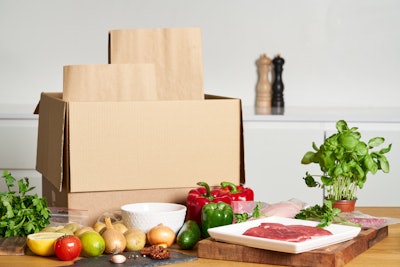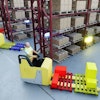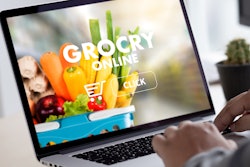
There’s no doubt the pandemic has changed pretty much everything, including the way people shop for food. As consumers spent more time eating at home, they also searched for ways to shop safely and incorporate more variety in their meals. They purchased more groceries online than ever before – having them shipped, delivered or ready for curbside pickup.
Consumer eating and shopping habits changed during the last year, and experts say the e-food momentum will continue, driven by the convenience of ordering online and new-found consumer interest in eating more at home.
Digital grocery is here to stay
In 2021, online grocery shopping will exceed $100 billion in spending for the first time, according to eMarketer. That’s a year ahead of previous estimates. And by 2022, it’s expected that more than half of the U.S. population will be digital grocery buyers.
What’s more, today’s consumers have access to many options when ordering food online. In addition to everyday grocery items, specialty food and meal kit sales have also grown and will continue to do so. Between 2018 and 2020, online shopping for specialty food skyrocketed by 170%, according to the 2021 State of the Specialty Food Industry Report. And by 2028, Grandview Research states the global meal kit delivery services market is expected to reach over $27 billion.
With so many choices available, it’s critical that packaging – both food packaging and transit packaging work together to deliver the convenience and quality that consumers desire.
Unpacking the importance of packaging
This new reality requires a total packaging system approach to meet e-commerce needs, and it involves more than simply adding items to a corrugated cardboard box for shipping.
Let’s start with primary or food packaging. It’s crucial for reducing damages during delivery, extending shelf life and avoiding leakage. It’s all about brand appeal and creating a positive experience for customers. Disappointed customers quickly become former customers. In fact, 70% of shoppers are unlikely to give you a second chance after a poor shipping experience.
That brings us to secondary packaging. It’s vital for reducing packaging waste and enhancing reusability. It also can guarantee your products arrive fresh and undamaged. This can be tricky because packaging requirements vary in different parts of the country. They can even change day to day based on weather and distance traveled.
Finding the right balance between adequate food packaging and transit protection is one of the key challenges online retailers face.
Consider these factors when developing an e-commerce packaging strategy:
● Product protection. Using void fill and cushioning will protect product during shipment, keep the package organized, improve its presentation and contribute to a positive unpacking experience.
● Temperature protection. Cold chain packaging protects temperature-sensitive products, reduces void fill and can minimize freight cost.
● Distribution cost. Last-mile delivery is one of the most expensive and time-consuming parts of the shipping process. It represents 53% of the total shipping cost, including fulfillment.
● Cube optimization. Package density is another factor to consider with shipping costs using dimensional (DIM) weight, a pricing technique assigned to a shipment based on volume versus weight. Using smaller, reliable protective packaging and vacuum packaging for e-food can help combat rising dimensional weight fees.
● Opening experience. While the primary purposes of packaging are protection and preservation, it also provides a direct connection to the end consumer and an opportunity to create a memorable moment for your brand.
Winning with omnichannel strategies
It’s also worth noting that while online shopping is on the rise, it’s not cannibalizing weekly trips to brick-and-mortar grocery stores. Rather, online is just another of the many channels that grocery shoppers use to meet their needs.
With this in mind, retailers will need to look for ways to optimize their profitability with packaging solutions that work across multiple channels – both online and in-store, since shoppers are expected to continue to shop in a variety of ways.
This means that retailers will need to commit to packaging that makes a great first impression; packaging that helps communicate brand messages and product claims that make your product stand out, whether at brick-and-mortar retail or online. For example, case-ready packaging that allows for printed messages with claims will help differentiate your product and entice consumers to purchase, rather than a plain tray overwrap without any messages.
Whatever channel consumers choose, there’s one thing that should be top of mind for every food retailer. Winning e-commerce demands a high-quality customer experience that protects your brand’s reputation across all channels.
Fresh remains a differentiator, regardless of selling channel
When it comes to online or in-store grocery shopping, one way to differentiate your brand is to choose the right primary packaging to ensure food items are the same quality and freshness that consumers would choose for themselves.
Look for features like freezer or oven-ready, easy open and reclosable packaging as well as packaging that helps maximize shelf life and is damage resistant and leak-proof. Options that are made for recycling and minimize waste are also top of mind with consumers.
Making the case for meat
Let’s look at fresh meat packaging, for example, and how it plays a role in addressing consumer expectations.
When shopping in a physical grocery outlet, consumers can compare cuts of meat for freshness, length of shelf life and overall quality. They look for packages that haven’t leaked and will keep their meat fresh until they are ready to use it.
But, when food is delivered to them, they don’t have that option. If their product arrives in the same condition they would choose for themselves, there’s a greater likelihood they will continue to buy meat online.
And, with consumer interest in shopping e-grocery for meat, as well as all groceries, on the rise, the proper packaging becomes even more vital.
The number of shoppers who purchased meat online nearly doubled in 2020 to 29%, and 59% say they expect to continue purchasing about the same amount online in 2021, according to the 2021 Power or Meat study.
This means it’s essential that your food packaging, including meat, delivers across all channels.
Choosing the right packaging solution could be the difference between a delighted customer who will shop e-commerce -- or any of your channels again – and a disappointed customer who won’t.
Packaging is a critical component of e-commerce strategy
With online grocery competition heating up, brands can differentiate themselves through better packaging solutions that enhance consumer experiences, drive repeat business, increase loyalty and build reputations.
But, packaging for successful e-commerce is not a one-size-fits-all solution, and it can be a daunting process. It takes a coordinated effort to ensure all your packaging solutions work together – both inside and out – all while meeting the most stringent requirements for regulatory safety and compliance.
Additionally, you’ll want to consider how packaging addresses sustainability goals, a growing concern among businesses and consumers alike. Choosing the best packaging to protect losses from food waste can have a significant impact on your carbon footprint when you consider the ripple effect of this waste -- from the energy it takes to grow and transport food to the greenhouse gases caused from food waste in the landfill.
And, it’s important that packaging protects your product and keeps it intact throughout its journey. Imagine the disappointment of opening a package only to discover your cheesecake has been flattened or your chocolate-covered berries have been crushed.
A total system approach – choosing the right food packaging that works together with the packaging you use to protect product in transit will help deliver the high level of quality and product protection needed to ensure consistently positive consumer experiences.



















